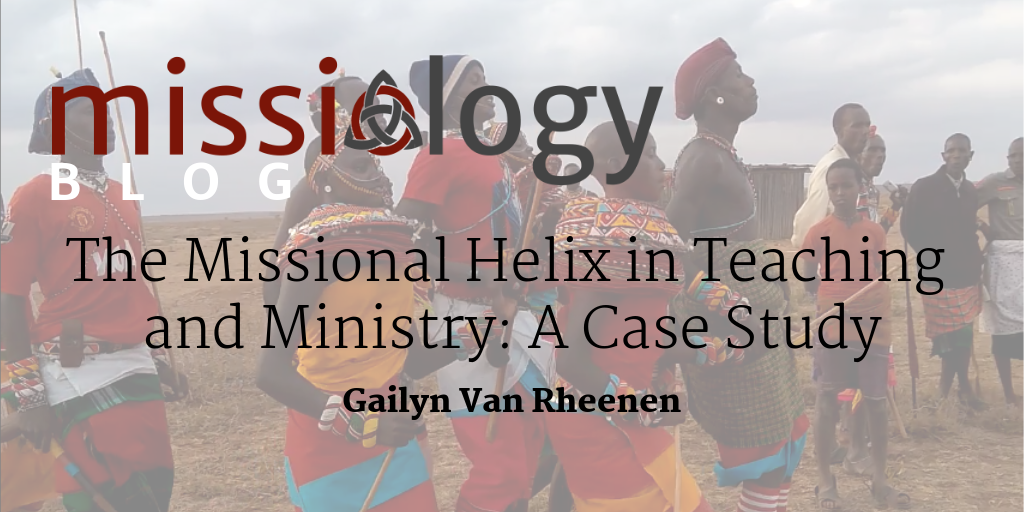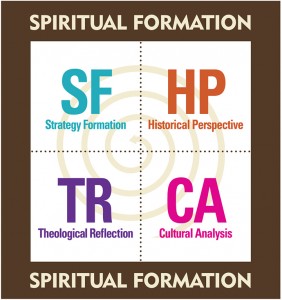
In teaching a seminar or class on Communicating Christ in Animistic Contexts,1 I briefly describe the interrelated sectors of the Missional Helix.2
Because animistic assumptions are typically foreign to those who are from the West or inculcated with Western cultural values, I typically begin this seminar with “Cultural Analysis.” I define “animism” along with significant terms like “divination” and “possession” and provide real life stories and my journey of learning and ministry. I try to give just enough historical and theological background that participants, especially those who are unknowingly secular, will not reduce animism to “primitive superstition.” This reflection on culture frequently engenders an appetite to feast on what the Bible says on the topic.
 During “Theological Reflection,” I give an overview of “God and gods” in the Old Testament, “Christ and demons” in the Gospels, and “the church and the principalities and powers” in Pauline literature. This reading of scripture begins to raise numerous questions that need answers: What is the nature of spiritual power in the Bible? What is the relationship of Christ and Satan to these powers? How does the Bible describe the way of Jesus in relationship to these powers? What is the difference between animistic and Christian power? Biblical phrases like “the kingdom of God,” “living in the heavenly realms,” and “waiting on the Lord” take on new, contextual meaning.
During “Theological Reflection,” I give an overview of “God and gods” in the Old Testament, “Christ and demons” in the Gospels, and “the church and the principalities and powers” in Pauline literature. This reading of scripture begins to raise numerous questions that need answers: What is the nature of spiritual power in the Bible? What is the relationship of Christ and Satan to these powers? How does the Bible describe the way of Jesus in relationship to these powers? What is the difference between animistic and Christian power? Biblical phrases like “the kingdom of God,” “living in the heavenly realms,” and “waiting on the Lord” take on new, contextual meaning.
During “Historical Perspective,” I tell a story of God of providing rain during a time of drought while we ministered among the Kipsigis of Kenya and the competing worldviews within me as I considered what happened when God immediately provided rain. Based upon this story, we then discuss various perceptions for the cause of rain during Pre-Modernity, Modernity, and Post-Modernity contrasting secular, animistic, and theistic responses. Is God truly the giver of rain?
During “Strategy Formation,” We seek Christ-formed ministry models by reflecting on various perceptions of truth encounter, power encounter, and cultural encounter to develop contextual, biblically-rooted patterns of ministry. The word “encounter” is used intentionally because animism is a belief that personal spiritual beings and impersonal spiritual forces have power over human affairs and that humans, consequently, must discover what beings and forces are impacting them in order to determine future action and, frequently, to manipulate their power. Cultural encounters occur during times of transition necessitating cultural understanding to form new customs that reflect the kingdom of God resulting in questions like: “What type of blessing rituals occur when children are born?” “What type of rites of transition summon blessings from God rather than other spiritual beings and forces?” “What occurs when Christians marry?” “What are elements of a Christian funeral?” and “How do these rites of transition reflect the kingdom of God rather than dependence on other spiritual beings and forces?”
For both leaders and the community of faith, “Spiritual Formation” occurs when Christians listen to God and spiritually discern His voice within the rhythm of theological reflection, cultural analysis, historical perspective, and strategy formation. This movement is continually happening in times of prayer, weekly meetings of communities of faith, seminars for leader equipping, etc. I remember a meeting of Kipsigis leaders when God spoke through us as a community telling us that we needed to discern the difference between Christian and traditional marriage. This spiritual impulse led us to change the direction of our meeting to discern rituals and practices that distinctively reflect the love and holiness of God within a Christian wedding ceremony. We first searched scripture as community to discern the nature of Christian marriage and then discerned rituals for a wedding ceremony that reflected these principles. It was a hilarious meeting with a few men imitating women as they roleplayed various events that occur in a Christian wedding ceremony that make it both distinctively “Christian” and contextually appropriate. A historical meeting in the life of a movement! One to remember!
Spiritual formation thus occurs on the journey as God in his Holy Spirit speaks to us and leads us to discern practices for Christian living. When leaders are intentionally empowered to read Scripture with the guidance of the Holy Spirit, their communities grow in faith and practice. Today “Christian” weddings have largely displaced “traditional” weddings.
Hopefully, this case study provides an example not only of a course using the Missional Helix but also its value in contemporary ministry.
Notes
1 Gailyn Van Rheenen, Communicating Christ in Animistic Contexts (Pasadena, CA: William Carey Library, 1991).
2 See idem, “What is Missiology,” Missiology Blog, http://missiology.com/blog/What-Is-Missiology-Gailyn-Van-Rheenen; idem, Missions: Biblical Foundations and Contemporary Strategies, 2nd ed. (Grand Rapids: Zondervan, 2014), ch. 13.
 Dr. Gailyn Van Rheenen served as a church-planting missionary to East Africa for 14 years, taught Missions and Evangelism at Abilene Christian University for 18 years, and is the founder and currently a facilitator of church planting and renewal within Mission Alive (www.missionalive.org). The second edition of his book Missions: Biblical Foundations and Contemporary Strategies was published by Zondervan/Harper Collins in 2014. Other publications include Communicating Christ in Animistic Contexts (William Carey Library) and The Changing Face of World Missions (Baker Academic; authored with Michael Pocock and Doug McConnell).
Dr. Gailyn Van Rheenen served as a church-planting missionary to East Africa for 14 years, taught Missions and Evangelism at Abilene Christian University for 18 years, and is the founder and currently a facilitator of church planting and renewal within Mission Alive (www.missionalive.org). The second edition of his book Missions: Biblical Foundations and Contemporary Strategies was published by Zondervan/Harper Collins in 2014. Other publications include Communicating Christ in Animistic Contexts (William Carey Library) and The Changing Face of World Missions (Baker Academic; authored with Michael Pocock and Doug McConnell).
 Blog
Blog
